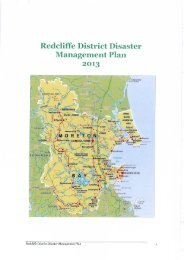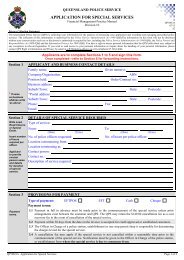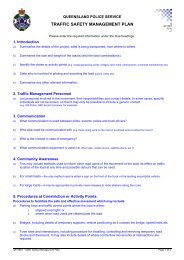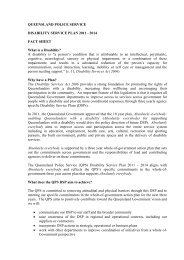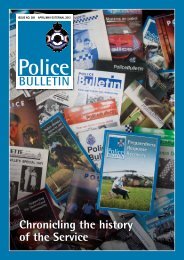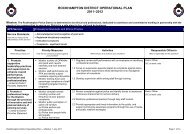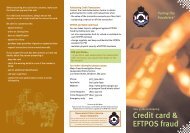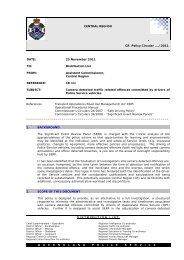- Page 1 and 2: 1. Introduction to Traffic Legislat
- Page 3 and 4: 1.2 Superintendent of traffic The C
- Page 5 and 6: (vi) s. 64: 'Power to inspect vehic
- Page 7 and 8: 1.4 Officers in charge to ensure at
- Page 9 and 10: 1.6 Signals for traffic regulation
- Page 11 and 12: 1.8 Police officer to supply office
- Page 13 and 14: Appendix 1.1 Life endangering offen
- Page 15 and 16: 152(1)+(2) Disobey overhead lane co
- Page 17 and 18: CRIMINAL CODE Section 328A Short Ti
- Page 19 and 20: 2.1 Definitions The definitions con
- Page 21: Breath test means a test to obtain
- Page 25 and 26: (i) monitoring and reviewing speed
- Page 27 and 28: 2.2 Legislation Acts Interpretation
- Page 29 and 30: 3. Interception by Police 3.1 Intro
- Page 31 and 32: 3.2 Static interception A static in
- Page 33 and 34: (c) Standard - use personal protect
- Page 35 and 36: (iii) strobe lights are used, where
- Page 37 and 38: Traffic build up at static intercep
- Page 39 and 40: (i) authority exists; (ii) the loca
- Page 41 and 42: (iii) the security of the intercept
- Page 43 and 44: Appendix 3.1 Static interception si
- Page 45 and 46: Appendix 3.3 Static interception si
- Page 47 and 48: 4. Driver Licences 4.1 Introduction
- Page 49 and 50: 4.2 Issuing of Queensland driver li
- Page 51 and 52: (iii) in appropriate circumstances
- Page 53 and 54: (i) a letter is completed on Servic
- Page 55 and 56: 4.5 Licences issued outside Queensl
- Page 57 and 58: enforcement action (see ss. 75 to 1
- Page 59 and 60: 4.8 Issuing infringement notices fo
- Page 61 and 62: POLICY Officers should issue a 'Per
- Page 63 and 64: 4.9 Alcohol ignition interlocks For
- Page 65 and 66: Unlicensed driving POLICY Section 7
- Page 67 and 68: ORDER (v) forward the correspondenc
- Page 69 and 70: 5. Traffic Crashes 5.1 Introduction
- Page 71 and 72: 5.2 Attending and investigating tra
- Page 73 and 74:
5.2.1 Action to be taken by officer
- Page 75 and 76:
5.3 Duties of first response office
- Page 77 and 78:
5.4 Duties at traffic crashes invol
- Page 79 and 80:
fairness to persons questioned for
- Page 81 and 82:
5.6.2 Responsibilities of officers
- Page 83 and 84:
(b) the name/s of the any other off
- Page 85 and 86:
(iii) mass, dimensions and loading;
- Page 87 and 88:
5.7 Supplying information relating
- Page 89 and 90:
5.9 Investigation of major incident
- Page 91 and 92:
If the Forensic Crash Unit, Brisban
- Page 93 and 94:
5.10 Traffic crashes at railway lev
- Page 95 and 96:
5.12 Emergency rescuer's guides 5.1
- Page 97 and 98:
5.13 Investigation of traffic crash
- Page 99 and 100:
Responsibilities of commissioned of
- Page 101 and 102:
POLICY (a) telephone the Officer in
- Page 103 and 104:
5.15 Indictable and simple offence
- Page 105 and 106:
Appendix 5.1 Emergency Rescuer's Gu
- Page 107 and 108:
(iii) It is important to appreciate
- Page 109 and 110:
• physically remove the 'proximit
- Page 111 and 112:
6.1 Introduction This chapter relat
- Page 113 and 114:
6.3 Speed detection devices 6.3.1 P
- Page 115 and 116:
(iii) where applicable, the particu
- Page 117 and 118:
to attend a speed detection or phot
- Page 119 and 120:
(ii) of the region in which the off
- Page 121 and 122:
6.6 Estimation POLICY The estimatio
- Page 123 and 124:
6.8 Amount of tolerance allowed in
- Page 125 and 126:
6.10 Warnings given to motorists ab
- Page 127 and 128:
7.8.5 Saliva analysis notice by ope
- Page 129 and 130:
7.2 Interception Authority to inter
- Page 131 and 132:
80: 'Breath and saliva tests, and a
- Page 133 and 134:
(i) for the purposes of requiring t
- Page 135 and 136:
(ii) have another officer present d
- Page 137 and 138:
providing a specimen of breath, an
- Page 139 and 140:
7.5.2 Persons authorised to take sp
- Page 141 and 142:
7.5.6 Certificate by analyst - bloo
- Page 143 and 144:
(viii) ensure after taking the spec
- Page 145 and 146:
(v) make the requirement for the su
- Page 147 and 148:
Section 79AA(2) of the Transport Op
- Page 149 and 150:
ecause of exhibited external signs,
- Page 151 and 152:
Where a specimen of blood for a lab
- Page 153 and 154:
(i) determine when the subject pers
- Page 155 and 156:
7.9 Handling of blood, urine and sa
- Page 157 and 158:
(c) of the remoteness of the area:
- Page 159 and 160:
(i) prior to the release of the sub
- Page 161 and 162:
7.12 Breath and saliva analysing in
- Page 163 and 164:
these cases officers should make ap
- Page 165 and 166:
7.14 Statistical returns for breath
- Page 167 and 168:
7.16 Servicing of breath or saliva
- Page 169 and 170:
7.18 Exculpatory provisions (defenc
- Page 171 and 172:
7.20 Private medical examination PO
- Page 173 and 174:
7.22 Observing the subject person a
- Page 175 and 176:
7.23 Children Questioning of childr
- Page 177 and 178:
Appendix 7.1 Drink and drug driving
- Page 179 and 180:
Appendix 7.3 Observation sheet Appe
- Page 181 and 182:
8.10.2 Procedure on receipt of comp
- Page 183 and 184:
8.2 Infringement notice An infringe
- Page 185 and 186:
8.4 Infringement notice system Infr
- Page 187 and 188:
8.5 Lost or misplaced infringement
- Page 189 and 190:
If an infringement notice has alrea
- Page 191 and 192:
8.6.7 Officers in charge to forward
- Page 193 and 194:
(xvi) where a local authority parki
- Page 195 and 196:
(b) that any enforcement action tak
- Page 197 and 198:
8.9 Defect Notices POLICY The Servi
- Page 199 and 200:
ORDER (a) issue an infringement not
- Page 201 and 202:
Motor Vehicle Inspection Centre and
- Page 203 and 204:
Officers in charge should ensure th
- Page 205 and 206:
(ii) prepare a letter to the owner
- Page 207 and 208:
(a) if no record of the infringemen
- Page 209 and 210:
8.11 Prosecutions pending list The
- Page 211 and 212:
8.13 Evidentiary notes required for
- Page 213 and 214:
8.15 Changes to local official traf
- Page 215 and 216:
8.17 Traffic Breach Report PT 57A:
- Page 217 and 218:
The PT 57A: 'Traffic Breach Report'
- Page 219 and 220:
8.18.3 Forwarding of transport brea
- Page 221 and 222:
Chapter 9 Photographic Detection De
- Page 223 and 224:
9.2 Photographic detection devices
- Page 225 and 226:
(iii) whether the problem requires
- Page 227 and 228:
Operators may add an approved site
- Page 229 and 230:
(b) ensure that a clear and uninter
- Page 231 and 232:
9.6 Complaints regarding offences r
- Page 233 and 234:
10.5.15 Significant Event Message 1
- Page 235 and 236:
10.2 Driving of Service vehicles ge
- Page 237 and 238:
(d) type of cargo/load contained in
- Page 239 and 240:
Where an officer driving a police v
- Page 241 and 242:
10.4 Vehicle interceptions 10.4.1 A
- Page 243 and 244:
10.4.5 Procedures after interceptio
- Page 245 and 246:
10.5 Pursuits 10.5.1 Pursuit Policy
- Page 247 and 248:
10.5.5 Risk assessment POLICY Prior
- Page 249 and 250:
(b) a description of the pursued ve
- Page 251 and 252:
(a) they have abandoned the pursuit
- Page 253 and 254:
10.5.15 Significant Event Message P
- Page 255 and 256:
would help in the investigation of
- Page 257 and 258:
(i) the owner of the motor vehicle
- Page 259 and 260:
Hearing of a forfeiture order appli
- Page 261 and 262:
the evading offence, the outstandin
- Page 263 and 264:
10.7 Use of force during a pursuit
- Page 265 and 266:
10.8 Review of police driving POLIC
- Page 267 and 268:
District investigation On receipt o
- Page 269 and 270:
11.1 Introduction This chapter prov
- Page 271 and 272:
Exemptions Part 5, Division 4: 'Exe
- Page 273 and 274:
(ii) issue and serve a F3612: 'Proh
- Page 275 and 276:
11.3 Registration offences Registra
- Page 277 and 278:
which is unregistered, the officer
- Page 279 and 280:
PROCEDURE (ii) registered operator
- Page 281 and 282:
11.5 Vehicle registration procedure
- Page 283 and 284:
12.1 Introduction This chapter outl
- Page 285 and 286:
12.3 Local government authorities m
- Page 287 and 288:
12.5 Special event permits and spec
- Page 289 and 290:
12.7 Road closures for special even
- Page 291 and 292:
12.8 Issuing of road closure permit
- Page 293 and 294:
12.10 Notification of relevant auth
- Page 295 and 296:
12.12 Road closures and road use re
- Page 297 and 298:
(iii) it is necessary for the perso
- Page 299 and 300:
12.13 Excess dimension vehicle perm
- Page 301 and 302:
(iii) original or copy of the permi
- Page 303 and 304:
12.14 Conduct of excess dimension v
- Page 305 and 306:
(iv) government authorities, local
- Page 307 and 308:
Recording competencies POLICY Polic
- Page 309 and 310:
13. Traffic operations and the reco
- Page 311 and 312:
13.2 Intelligent Traffic Analysis S
- Page 313 and 314:
(iii) if sufficient evidence exists
- Page 315 and 316:
13.4 WebCrash WebCrash is an on-lin
- Page 317 and 318:
14.1 Introduction This chapter deal
- Page 319 and 320:
14.3 Radar detectors and similar de
- Page 321 and 322:
(iv) officials of an international
- Page 323 and 324:
14.6 Driver Reviver Program The Dri
- Page 325 and 326:
14.8 Motor vehicles with missing, s
- Page 327 and 328:
(i) inspect the motor vehicle and a
- Page 329 and 330:
15.1 Introduction In accordance wit
- Page 331 and 332:
15.3 Procedures for motorbike noise
- Page 333 and 334:
15.5 Application for impounding ord
- Page 335 and 336:
15.7 Execution of motorbike noise o
- Page 337 and 338:
16. Impounding motor vehicles 16.1
- Page 339 and 340:
16.2 Powers for impounding motor ve
- Page 341 and 342:
16.4 Procedures for Type 1 Vehicle
- Page 343 and 344:
(ii) found guilty of the same type
- Page 345 and 346:
16.7 Applications for impounding or
- Page 347 and 348:
16.8 Application for impounding ord
- Page 349 and 350:
16.10 Execution of impounding and f
- Page 351 and 352:
16.12 Release and recovery of motor
- Page 353 and 354:
16.14 Costs of storage of impounded
- Page 355 and 356:
16.16 Disposal of impounded/forfeit
- Page 357 and 358:
16.18 Charges withdrawn or dismisse
- Page 359:
TM Issue 21 - July 2013 (Public Ver





